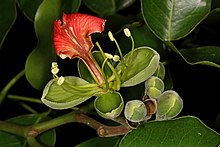|
Afzelia quanzensis
Afzelia quanzensis (pod mahogany, Afrikaans: peulmahonie, Venda: mutokota, Zulu: inkehli) is a species of tree native to sub-Saharan Africa.[3] It ranges from Somalia and Democratic Republic of the Congo to South Africa.[2] It is a protected tree in South Africa.[3] DescriptionThis deciduous tree can grow up to 20m in height, and has smooth, grey bark, which can flake in irregular patches. It has glossy dark green leaves and blooms between October and November. The flowers have one large red petal. After flowering, it produces a seed capsule, a thick wood-like pod, which contains black seeds with a hard, bright red aril covering one end.[4] UsesThe seeds are sometimes made into native necklaces and the timber is an ornamental and lumber hardwood, used in furniture, parquet flooring and railway sleepers.[4] This plant may be used in traditional medicine.[5] See alsoReferences
External links
|
||||||||||||||||||||||||||||||||||||||||||


